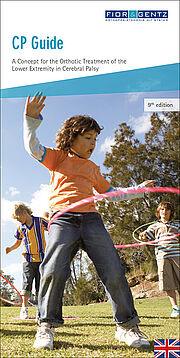What is Cerebral Palsy?
Cerebral palsy (for short CP) is a collective term for postural and movement disorders that are the consequences of early childhood brain damage. Other terms include cerebral paresis, infantile cerebral palsy or cerebral poliomyelitis. Cerebral palsy is permanent, but changes as the child grows and develops. An exact limitation of the term is difficult, as there is no universally recognised clinical picture.

How Does Cerebral Palsy Manifest Itself?
The main characteristic of cerebral palsy is the impaired motor function. Because areas of the brain that control movement are damaged, the muscles cannot work together in a coordinated way. Affected people display uncontrolled, spasmodic, sudden or inharmonious movements. Furthermore, problems with sensors, perception, communication, etc. can occur.
Causes of Cerebral Palsy
The damage occurs during pregnancy, birth or within the first year of life. Illnesses of the mother, lack of oxygen during birth or severe illnesses of the child during the first months of life can be causes.
Why an Orthosis Helps
The impaired motor function results in the muscles in one or both legs being controlled incorrectly when standing or walking. The muscles that are actually functional are too weak to carry out the desired movement due to incorrect control. As a result, people with cerebral palsy often lack the necessary stability when standing and walking. In many cases, this leads to spasmodic, spastic conditions of the affected muscle groups. In addition, compensatory stance and gait patterns often develop in the early stages of development to compensate for the lack of stability. These are difficult to correct and often get worse. The treatment with an orthosis as a medical device should therefore be carried out as early as possible in order to achieve safety when standing and walking. This can largely limit the development of compensatory gait patterns. On the one hand, the orthosis must allow the necessary movement (dynamics) in the upper ankle joint, and at the same time, it must take over the high forces emanating from the body weight in the ankle joint in order to compensate for the lack of stability. This compromise is made possible by an orthosis with NEURO SPRING system ankle joint. The orthosis supports when walking and provides support during stance. Depending on the requirements and settings, an orthosis has the following effects:
- muscle activation
- function improvement
- posture correction
- foot lifting
- regulation of muscle tension (muscle tone)
Due to the complex clinical picture, there is no universal treatment. In addition, most patients are growing and developing. A continuous adaptation to the circumstances is therefore necessary. The physician, physiotherapist and orthotist have a common goal which must be pursued together. The connection of the different disciplines offers good conditions for a successful treatment.
Concept for the Treatment with an Orthosis in Cerebral Palsy
The CP Guide with its “concept for the orthotic treatment of the lower extremity in cerebral palsy” aims at building a bridge between all parties involved. This includes patients and relatives as well as physicians, orthotists and physio- and occupational therapists. The guide contains an overview of the different gait types according to the Amsterdam Gait Classification. A treatment suggestion is presented for each gait type and the effect of the orthosis is described.
Click here to download the CP Guide free of charge and to learn more about the topic of cerebral palsy and the treatment with an orthosis. Upon request, we will gladly send you a printed copy. Please contact our In-house Customer Service at info(at)fior-gentz.de or +49 4131 24445-0.
You will find an overview of the different system joints in the knee and ankle area here. The most important functions of the respective system joint are explained in the corresponding product description.
You can get to know patients who have already been treated with an orthosis in our User Stories and Patient Videos. You can find the section about patients with CP here.
